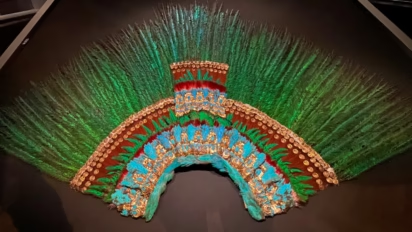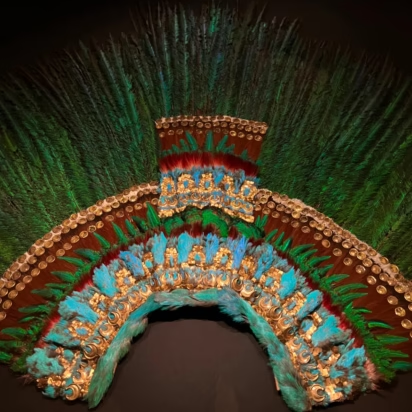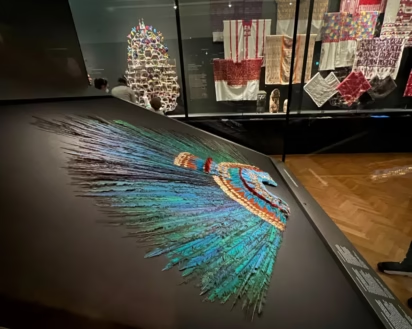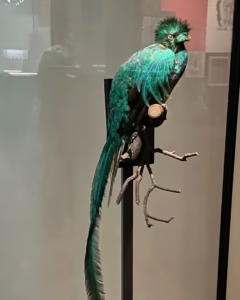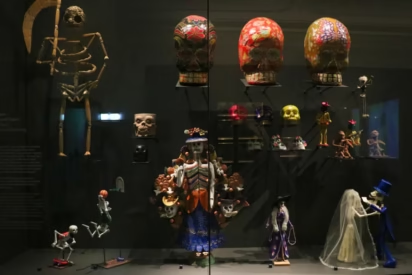The Penacho de Moctezuma — the only remaining pre-Columbian Aztec feather headdress from Mexico in the world — is the most famous item in the Weltmuseum Wien (World Museum of Ethnology in Vienna).

The most famous item on display in the Weltmuseum Wien (World Museum Vienna) is the Aztec quetzal feather headdress often referred to as the Penacho de Moctezuma. This is the only feather headdress in the world to have survived from pre-Columbian Mexico. It dates from before 1520 but its history before it ended up in the ethnological collection in Vienna is murky. Tickets to the Weltmuseum Wien include admission not only to Vienna’s World Ethnology Museum but also to the large Imperial Armory and Collection of Old Musical Instruments.
Only Aztec Feather Headdress in the World in Vienna
The famous quetzal Aztec feather headdress in the Weltmuseum Wien is the only one from pre-Columbian Mexico to have survived to the present. Although much researched, it remains unclear exactly how and when it left Mexico, how it came to Austria, and more significantly what its actual role and importance in Aztec culture were.
The feather headdress is the subject of a low-intensity dispute between Mexico and Austria. Of course, the Mexicans want it back and generally refer to it as the Penacho de Moctezuma, while the museum uses the more neutral (and factually correct) el tocado de plumas or El Penacho del México Antiguo. The current argument is that the headdress is too fragile for transportation — Mexican experts (more than the Mexican people) generally agree.
Aztec Feather Headdress in the Weltmuseum Wien

The Aztec feather headdress was made over 500 years ago in Mexico. It is famous for its bright green and blue quetzal feathers with sewn-on gold detailing. Everything is held in place by three delicate nets stabilized by thin wooden rods that can only seen on the rear. It would have been tied to the wearer’s head by straps.
Even a physical description of the headdress is not simple and undisputed. It was for centuries thought to be a standard that would have been carried flat on a pole in the European tradition. Only during the late 19th century was it realized that it was a headdress but it is still displayed flat, which probably contributed to its preservation. (The modern North American headdress in a nearby room shows a rounded display, although the Aztec version was probably again dressed somewhat differently.)
The front is well described in Wikipedia: “It is 116 cm (46 in) high and 175 cm (69 in) across and has the form of concentric layers of different colored feathers arranged in a semicircle. The smallest is made from blue feathers of the Cotinga amabilis (xiuhtōtōtl) with small plates of gold in the shapes of half moons. Behind this is a layer of Roseate spoonbill (tlāuhquechōlli) feathers, then small quetzal feathers, then a layer of white-tipped red-brown feathers of the squirrel cuckoo, Piaya cayana, with three bands of small gold plates, and finally two of 400 closely spaced quetzal tail feathers, some 55 cm (22 in) long. “
The headdress was restored and possibly altered through the centuries. Known conservation work was carried out in 1878 and 1992.
Provenance of the Aztec Feather Headdress in Vienna
The provenance of the headdress is largely unattested. Although it is commonly referred to “El Penacho de Moctezuma” in Mexico, it almost certainly did not belong to the Aztec ruler and was not a royal crown.
Many similar headdresses were used in Mesoamerica and were associated with rulers, gods, priests, and warriors. Due to the fragility of the feathers, this is the only one that survived.
It is generally considered that the headdress came to Europe among the first artifacts sent home by the Spanish after the conquest of the Aztec Empire (1519-21). It was first mentioned in writing in 1596 as being in Schloss Ambrass near Innsbruck. It came to Vienna in the early 19th century and has been in the Weltmuseum since 1928. (Except for the last fact, much of the earlier history is disputed.)
See the Mexican Feather Headdress in the Weltmuseum Wien
The quetzal feather headdress is on permanent display in the Mesoamerica hall of the Weltmuseum Wien. It has its own climate and light-controlled glass case with descriptions in German, English, and Spanish. Visitors from Mexico tend to linger.
Worth noting in a nearby display case is a nineteenth-century taxidermy mount of a Quetzal bird. This small bird with its famous long tail feathers was not indigenous to the Aztec Empire but the Aztec’s military power ensured that the highly valued feathers were delivered regularly as tribute.
The natural habitat of the endangered Quetzal bird is in southern Mexico and especially Guatemala, where it appears on the national flag and in the name of the currency.
More Art from Mexico in the Weltmuseum Wien



Although the Aztec feather headdress is the most famous item in the museum and the reason why the Weltmuseum is probably the most visited museum in Vienna by Mexicans, further interesting items from Mexico and Central America are on display in the same room.
The museum has other featherwork items from Mexico, including some from the colonial period, but two pre-Columbian items that also came to the Weltmuseum via Schloss Ambrass are the more interesting. An insignia (or fan?) has a large blue feather ring with more brightly colored inner rings and a butterfly at the center. The feather shield with a coyote is one of only four that survived to the present — the other two are in Stuttgart while Maximilian returned the fourth to Mexico. Many more were imported to Europe but were destroyed when the European nobility used them in parades or at fancy dress parties. (This one was long wrongly described as a Chinese sunshade with a dragon.)
A few pre-Columbian stone figures are on display. The mother goddess (or maize goddess) confirms the importance of corn to Mexican culture and diet. A seemingly simple supporting figure that could be used like table legs could date from as early as AD1000 or as late as AD1500 — the Aztecs revered such objects from earlier cultures but also copied the style in their own works.
The museum has some Christian-theme objects from the colonial period that show how Mexicans often blended traditional beliefs with the new religion. Further items were collected during the ill-fated reign of the Austrian Habsburger Maximilian as emperor of Mexico (1864-67).
More modern items from the 20th century to the present include ceramic and paper mache images that continue to be very popular in modern-day Mexico. A large ceramic market tree has over 60 market stalls. Decorated skeletal figures and skulls continue to be very popular in Day of the Dead celebrations in Mexico.
Visiting the Weltmuseum Wien
The Weltmuseum Wien is open daily except Wednesday from 10:00 to 18:00, closing at 21:00 on Tuesdays. The museum is closed on Wednesdays.
The Ticket Neue Hofburg gives admission to all three museums in this wing of the Hofburg: the Weltmuseum Wien (Ethnology), the Hofjagd- und Rüstkammer (Hunting and Armory), and the Sammlung Alter Musikinstrumente (Collection of Old Musical Instruments). Separate tickets for the three museums are not sold.
→→ See also Visiting the Weltmuseum Wien for more details on the rest of this large and interesting ethnological collection in the heart of Vienna, which includes a large collection of Benin bronzes.
